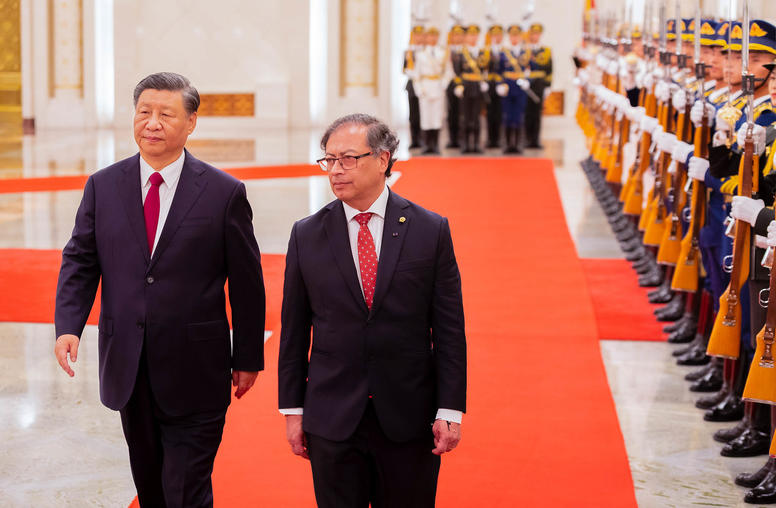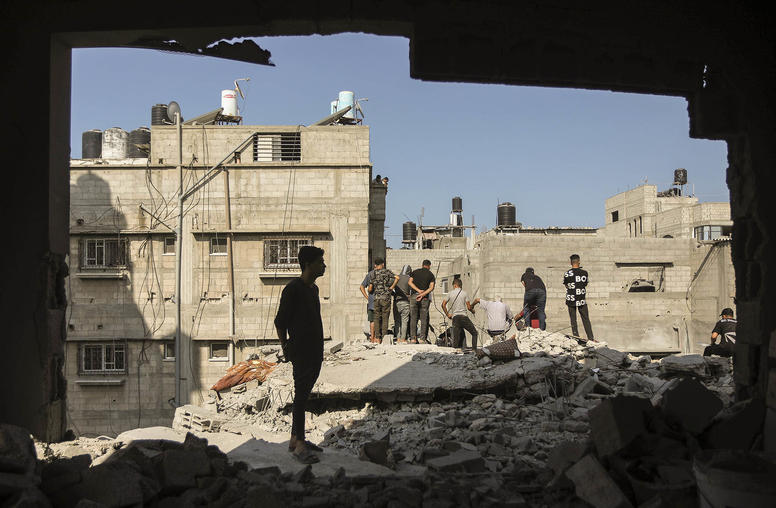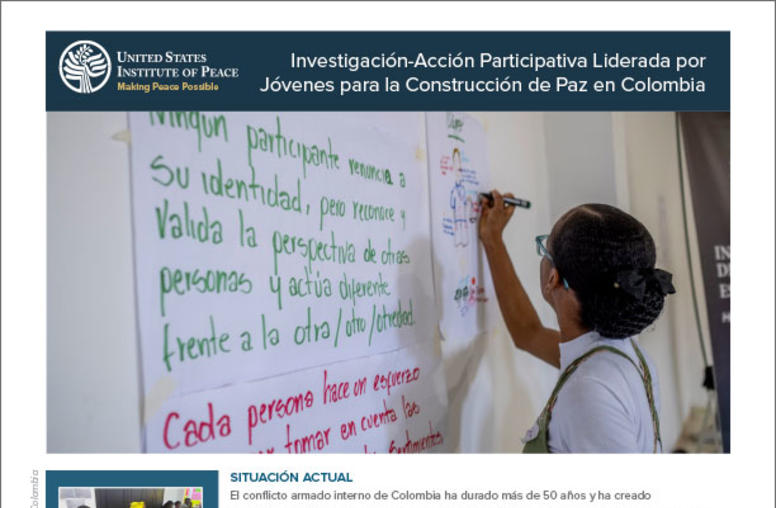Protests in Colombia
Testimony before the Tom Lantos Human Rights Commission
Steve Hege, regional deputy director for Latin America, testified on July 1, 2021 at the Tom Lantos Human Rights Commission's hearing on "Protests in Colombia." His expert testimony as prepared is presented below.
Co-Chair McGovern, Co-Chair Smith, and distinguished members of the Commission, thank you for inviting me to testify at this important hearing on the complex current situation in Colombia.
I am the Deputy Director for Latin America at the United States Institute of Peace, although the views expressed here are my own. The U.S. Institute of Peace was established by Congress as an independent, nonpartisan national institute to prevent and resolve violent conflicts abroad, in accordance with U.S. national interests and values.
I would like to frame my remarks today around two considerations based on the Institute’s work in Colombia: the linkages between the current protests and the ongoing armed conflict; and the challenges of dialogue and negotiations.
Linkages to the Ongoing Armed Conflict
Despite the historic 2016 peace agreement with the FARC rebels, a plethora of armed and criminal groups – collectively totaling nearly 20,000 individuals – have continued to expand and gain strength throughout the country in recent years leading to dramatic upticks in massacres, gruesome exemplary acts of violence, and the targeting of local and national social leaders. This ongoing armed conflict has both served as the backdrop for and permeated the protests despite their unique motivations and dynamics. Even before the current crisis, 93% of Colombians felt that insecurity had increased in their immediate regions and cities.
While the FARC peace deal focused on redressing the long-neglected inequalities between the rural countryside and the urban centers, the stark challenges faced by the inhabitants of cities have largely been the locus of the current national crisis. Nevertheless, there are several important linkages between the protests and the ongoing armed conflict.
First, many of the youth who have assumed prominent local leadership on the “front lines” of protests are the children of the millions of families who were forcibly displaced to urban centers by the armed conflict and have been unable to escape cycles of violence and poverty.
Secondly, the limited implementation of the first chapter of the 2016 peace accord on comprehensive agrarian and land reforms have not only made it more difficult for sustainable returns of these families to the countryside but have undermined regional markets for small-scale farming produce which could alleviate urban hunger that has been exacerbated by the pandemic.
Thirdly, the FARC peace accord included critical provisions to generate acceptable parameters of peaceful protest and the common practice of impeding mobility and commerce which has been a dramatic point of contention during the current national crisis. However, the participative process in 2018 which led to a detailed bill proposal has languished in Colombia’s Congress for the last three years leaving wide-ranging divergence of understanding and interpretation of the limits of these rights.
Fourthly, the plethora of remaining armed and criminal groups, including growing FARC dissident factions, have been accused of orchestrating some violence and unrest. While no doubt their local commanders continue to seek to take advantage of the crisis and have allegedly led arson attacks on local court buildings, if these groups had the intention and capacity to alone generate such levels of national turmoil they would have certainly done so on numerous previous occasions. Some criminal groups are actually targeting protesters blocking key routes for illicit trafficking. More concerning though is the reality that enraged and disillusioned youth are likely to be prime targets for recruitment should the strike not result in their demands being redressed to a degree which would have justified the sacrifice and trauma of these past two months.
Furthermore, the emergence of groups of armed civilians targeting protesters has hearkened back to the country’s dark history of paramilitarism. “Good people” have been called to take up arms and resist what they view as an uncontrollable popular uprising. Indiscriminate attacks on indigenous marches by such groups in Cali and subsequent violent responses have also deepened racial tensions in the already deeply polarized country.
Finally, such private armed actors have emerged alongside a deep crisis of legitimacy and effectiveness of the security forces which were largely left untouched by the 2016 peace agreement. Police peacebuilding units with stronger emphasis on community engagement were limited to accompanying the FARC’s successful disarmament process and their approaches have not yet been adopted more broadly within the institution.
Current indignation over violent clashes with police has given life to renewed calls for enhanced accountability mechanisms and security sector reform in addition to tragically turning many overwhelmed police stations into the object of rage and vandalism. Recent efforts to revamp the police, however, have yet to take up root as legislation has waned in Colombia’s Congress and been completely disconnected from justice reform proposals. Internal police plans to alter the militaristic posture and ethos of the institution — including a change to more civilian blue uniforms and the use of body cameras — have not yet been enacted despite President Duque’s announcement of a ten-point plan prior to the recent visit of the Interamerican Commission on Human Rights.
While much debate has revolved around the problematic placement of the police within the Ministry of Defense and the military justice system, deeper issues regarding holistic criminal justice needs, ideological indoctrination driven by the armed conflict, intelligence biases related to conspiracy theories, and the politicization of officers have received little attention. A national poll earlier this month found that 85% of youth below the age of 24 have a negative image of the police who, for their part, increasingly view many of this sub-set of citizens in an equally distrustful fashion.
Challenges of Dialogue & Negotiations
Countless voices have repeated calls for broad-based dialogue as the key to unlocking solutions to the national crisis. However, since November 2019, two separate processes responding to previous periods of mass protests and unrest were largely considered unproductive and ultimately abandoned, fueling mistrust and apprehension of being roped into elaborate listening sessions which only lead to unilateral measures. Additionally, security operations to forcefully dismantle many roadblocks with overwhelming force, have only heightened tensions and undermined efforts to build the minimum levels of trust to undertake transformative processes. Furthermore, nearly entering into his final year in office and with only 16% of Colombians approving of his leadership according to recent polls, President Duque has little time or political capital to invest in a truly inclusive and transformative dialogue process as pervasive socio-political polarization ramps up in preparation for general elections in less than twelve months.
While the Catholic Church helped broker a promising seven-point negotiations agenda and pre-accord on the right to social protest with the National Strike Committee – comprised of the country’s largest union leaders – the process has since been abandoned after the government conditioned talks on the removal of all blockades across the country. The pandemic’s brutal peak led strike leaders nationally to postpone calls for future marches until the country’s Independence Day of July 20th, likely setting up another cycle of tension and unrest. Taking advantage of the relative lull at present, the government has unilaterally submitted another tax reform bill without broad buy-in or input.
Meanwhile, throughout major urban centers, youth “front-line” protest leaders, who have felt largely unrepresented by the National Strike Committee, have slowly built entrenched ecosystems of resistance, including representation and collective decision-making structures which local and national authorities have largely refused to recognize and engage with meaningfully. These youth routinely highlight the need for legitimate fact-finding exercises to document and clarify the major events of the recent months, the decriminalization of protests with unreasonable fines and threats of imprisonment in addition to expanded access to and investment in public higher education beyond tuition remission alone – among other important considerations.
Overall, the dramatic diversity of local demands that have been galvanized by the crisis requires the adoption of more complex multi-level dialogue processes with mechanisms incorporated specifically for subnational leaders to forge actionable, concrete agreements. Some protest leaders and prominent universities have even been clamoring for a deeper decentralization of democratic and participatory decision-making structures, which go beyond the limits of the 1991 constitution and bypass traditional national political elites. With Colombia’s immense ingenuity, initiatives to develop and strengthen such dialogue processes deserve the full support of the United States during the remainder of the current Colombian administration and following next year’s elections.
Thank you, again, for the opportunity to testify before the Commission. I look forward to answering your questions.
The views expressed in this testimony are those of the author and not the U.S. Institute of Peace.


